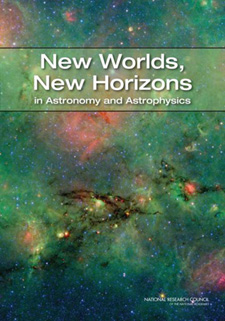Several UC Santa Cruz faculty members contributed to a new report from the National Research Council (NRC) that identifies the top priorities for astronomy and astrophysics research in the coming decade. The decadal survey--the NRC's sixth--prioritizes activities based on their ability to advance science in key areas.
The report is enormously important to astronomers and astrophysicists because of its influence on the funding decisions of agencies such as the National Science Foundation (NSF), NASA, and the U.S. Department of Energy (DOE). At UCSC, dozens of scientists crowded into a conference room in the Interdisciplinary Sciences Building to watch a live webcast of the public briefing at which the report was presented on Friday, August 13.
Claire Max, professor of astronomy and astrophysics and director of the Center for Adaptive Optics, and Steven Ritz, professor of physics and director of the Santa Cruz Institute for Particle Physics, both served on the committee that prepared the report. The committee's extensive review of the field included input from nine expert panels, six study groups, and a broad survey of the astronomy and astrophysics community. Stan Woosley and Puragra Guhathakurta, professors of astronomy and astrophysics, and Piero Madau, professor of physics, all served on expert panels.
"There was a huge amount of community participation in this process, so a very large number of people were involved in providing input to the committee," Ritz said. "Also, for the first time, we did independent assessments of the proposed projects in terms of technical readiness and schedule and cost risks, and we made our program recommendations fit within the budget guidelines from the funding agencies."
The survey committee chose three top science objectives: searching for the first stars, galaxies, and black holes; seeking nearby habitable planets; and advancing understanding of the fundamental physics of the universe. According to the report, "These three objectives represent unprecedented opportunities now becoming within our capability to explore. The discoveries made will surely lead to new and sometimes surprising insights that will ... bring us closer to understanding the cosmos and our place within it."
The committee's proposed research program includes a balance of small, medium, and large initiatives, both on the ground and in space. For large space-based activities (exceeding $1 billion), the top priority is a "Wide-Field Infrared Survey Telescope," which would help settle fundamental questions about the nature of dark energy, contribute to the search for other Earth-like planets, and survey our galaxy and others. For large-scale ground-based initiatives (exceeding $135 million), the first priority is the Large Synoptic Survey Telescope (LSST), a wide-field optical survey telescope that would observe more than half the sky every four nights and address diverse areas of study, such as dark energy, supernovae, and time-variable phenomena. Terry Schalk, adjunct professor of physics, is currently working on the camera for the LSST.
Another priority for large ground-based projects is a "Giant Segmented Mirror Telescope," a large optical and near-infrared telescope that will "revolutionize astronomy," the report said. Three international projects are currently competing to build the first such telescope, two involving U.S. scientists--the Thirty-Meter Telescope (TMT) and the Giant Magellan Telescope (GMT). Jerry Nelson, professor of astronomy and astrophysics, is project scientist for the TMT, which involves many astronomers at UCSC and UC Observatories.
The federal government will only be able to support one of those two projects, and the committee recommended that the NSF move quickly to choose which one it will invest in. "They've got to figure that out as soon as possible," Max said. "NSF has done reviews of both projects, so they're very capable of making that decision."
Other recommendations in the report include the formation of a "Midscale Innovations Program" within the NSF astronomical sciences division that would fill a funding gap for compelling research activities that cost between $4 million and $135 million.
"I'm particularly happy about the recommendation to keep mid-size projects alive," Max said. "In the past, when a big project has had a cost overrun, it has tended to eat up smaller projects, and the committee was emphatic that that must not happen."
Ritz said the committee worked hard to include a balance of projects, from large-scale initiatives to smaller, moderate-cost projects. "There were probably ten times more proposed projects than could fit in the budget, so not everything could be done. But I think we've shown that, even with budget scenarios that are not particularly rosy, we can still do some very exciting science," he said.
The report notes that astronomical research continues to offer significant benefits to the nation beyond astronomical discoveries by capturing the public's attention and promoting general science literacy and proficiency. In addition, the research serves as a gateway to science, technology, engineering, and mathematics careers, and a number of important and often unexpected technological breakthroughs. The report makes several recommendations to improve astronomy and astrophysics education and calls for more U.S. participation in international research projects.
The study was funded by NASA, NSF, DOE, and a contribution from the Vesto Slipher bequest to the Academies. The National Academy of Sciences, National Academy of Engineering, Institute of Medicine, and National Research Council make up the National Academies. They are private, nonprofit institutions that provide science, technology, and health policy advice under a congressional charter. The NRC is the principal operating agency of the National Academy of Sciences and the National Academy of Engineering.
The report, New Worlds, New Horizons in Astronomy and Astrophysics, is available online fromNational Academies Press.



